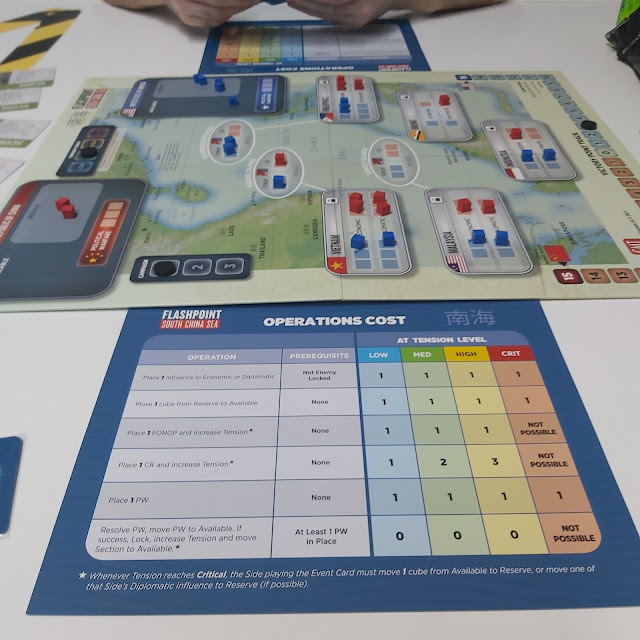This product has been provided by GMT to perform this review
The cubes represent the abstraction of political, economic and military influence. The game will revolve around 5 countries and 3 conflict zones. The conflict zones are linked to the tension marker, when placing a cube the tension will increase by 1, causing the cost of an action to vary and when reaching the critical level there will be actions that cannot be carried out. The game is a CDG you will spend the card points to place cubes, play the event or use it to activate a victory score card. An operation that should be highlighted is Political Warfare, it is a very powerful operation, since it allows you to block a country, and you can remove cubes from the rival. At key moments it can be a decisive operation. The game is decided in 3 rounds, there is little time, and you have to think very well about the decisions you are going to make.
The way of scoring the different zones is the first time I've seen it in a game. I don't know how it hasn't been used before. The cards have a symbol in their lower left corner that matches the different scoring cards. By playing that card, you can decide to score. The scoring card itself gives you a limit on the number of victory points you can earn. That card is flipped over and cannot be scored further for the rest of the round. The one with the greatest difference in cubes will score that difference.
The game is very replayable, it always feels fresh. After the first game you will only play with the help sheet and the games will not exceed 25 minutes.
This is a personal opinion. The entire deck is never played, and I love this. In other minimalist games you can memorize what cards are being played and when the deck runs out you can know what cards your rival has. Lie so much, in this way uncertainty is created.
We are facing the best launch of GMT so far this year. It shows the effort and love put by its designer. Moreover, it has become my recommendation for players who want to start in the CDG. This is going to be the first game in a series, it sets the bar very high.
If you want to buy it you can do it here
Components
We have a game with few components, but with exceptional quality. The colors of the map are perfect and the selection of photos is magnificent. The rules are well explained and with plenty of examples. The script to play alone does not seem very complicated. The quality is a little higher than what we are used to GMT. I can only put one downside, the distribution of the boxes to put the cubes. If you trust the photo below you can see that the USA box and its victory points are placed on the right, but when it comes to placing the cubes you do it on the left, this makes it unintuitive. It is an unimportant detail, but I like to pay attention to those details.Gameplay
The way of scoring the different zones is the first time I've seen it in a game. I don't know how it hasn't been used before. The cards have a symbol in their lower left corner that matches the different scoring cards. By playing that card, you can decide to score. The scoring card itself gives you a limit on the number of victory points you can earn. That card is flipped over and cannot be scored further for the rest of the round. The one with the greatest difference in cubes will score that difference.
Conclusions
The game revolves around the China Sea. Although the theme may be indifferent, the gameplay and the tension will still be present. With the current situation these issues are very present and everyone will know something or will be able to recognize some events from the cards.
The duration of the games is fair, the game will be neither short nor long. The game is very balanced, of all the games we have played there has never been an automatic victory. Also, the score has never been high, only 3 or 4 points difference.







No hay comentarios:
Publicar un comentario